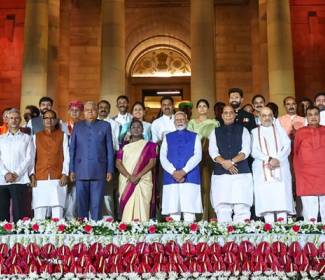Launched in 2015, the Digital India program has become a transformative force, altering the pace of India’s growth story while transforming the country into a digitally empowered society and a knowledge-based economy. This vision is being realised through three key pillars: robust digital infrastructure, accessible government services, and empowered citizens.
The foundation of India’s digital transformation lies in building a ubiquitous digital infrastructure to ensure ease of living. The Digital India initiative has been instrumental in achieving this goal, and it has been extended with a total budget of ~INR 14,903 Cr from 2021-22 to 2025-26.
New Digital Services: An era of accessible governance
Governance has undergone a major revamp, transitioning from cumbersome analogue processes to seamless online platforms. The National e-Governance Division (NeGD) has been playing a pivotal role in this, supporting the Ministry of Electronics and Information Technology (MeitY) in areas such as programme management, project development, technology management, capacity building, awareness and communications-related activities under the flagship Digital India Programme. NeGD has developed and is managing several National Public Digital Platforms such as DigiLocker, UMANG, Rapid Assessment System, OpenForge, API Setu, Poshan Tracker, National AI Portal, MyScheme, India Stack Global and many others.
To bring transparency in government procurement, the Government has come up with e-Marketplace (GeM), a dedicated platform for different goods & services procured by government organisations/departments/PSUs, offering 11,900 product categories and 321 service categories. Similarly, initiatives like MyGov and UMANG empower citizens with direct access to many government services, streamlining interactions and increasing accountability. Back-end digitisation fosters data-driven decision-making, driving efficient policy formulation and resource allocation.
Strengthening the digital revolution, initiatives like Aadhaar, the unique digital identity program, have empowered millions with access to essential services and financial inclusion. Aadhaar holders executed ~2 Bn authentication transactions in April 2023, a jump of more than ~19% over April 2022, indicating the growth of the digital economy and usage of Aadhaar in India.
In order to enable citizens to use digital services, high-speed internet connectivity is being extended to even the most remote parts of the country. There are over 888 Mn broadband users in India as of October 31, 2023. With 5,90,020 Common Service Centres (CSCs), including 4,68,773 CSCs in rural areas, India is working on a mission mode to bridge the digital divide. This connectivity underpins a thriving digital economy, fostering innovation and entrepreneurship.
Empowering citizens is at the heart of Digital India. Initiatives like Digilocker provide secure document management, while regional language email services like DataMail bridge the linguistic gap. Pradhan Mantri Grameen Digital Saksharta Abhiyan (PMGDisha), the world's largest digital literacy program, equips rural communities with essential digital skills like marketing, e-commerce, finance, and cybersecurity, enabling them to participate fully in the digital economy. Under the scheme, 4,38,570 PMGDisha training centres in India have certified ~47 Mn trainees.
Technologies Catalysing Digitalisation
Emerging technologies have played a key role in fuelling the growth of the Indian economy. Technologies like cloud computing and artificial intelligence have helped businesses in India become more efficient and productive. By harnessing these technologies, they gain access to predictive analytics that identify trends and customer preferences. An insight into some emerging trends in this field:
Artificial Intelligence
Integrating AI offers automation in governance and enhanced protection against evolving threats, safeguarding both government and businesses. The Government has also established the IndiaAI initiative to leverage transformative technologies to foster inclusion, innovation, and adoption for social impact. The FY 2022-23 Union Budget also outlined plans to set up three AI centres of excellence in premier educational institutions, a significant step towards making ‘Make AI in India and Make AI work for India’. The initiative aims to foster interdisciplinary research to develop cutting-edge applications and scalable problem solutions in the areas of agriculture, health, and sustainable cities, which will galvanise an effective AI ecosystem and nurture quality human resources in the field.
In September 2023, the Government of India, in collaboration with the EKstep Foundation, launched an AI chatbot with PM-Kisan, India’s direct benefit transfer program for farmers, to extend financial help to farmers who own their land. This farmer-friendly bot helps check eligibility and payment status and solve grievances, all with voice commands. Over 5 Lakh farmers used it on day one, depicting the level of penetration and acceptance AI is receiving in India.
The demand and supply gap for digital tech talent is expected to increase by 3.5 times by 2026, making the next 25 years a watershed moment for India to establish itself as a technological and economic powerhouse. Addressing the growing demand for tech talent, MeitY has also set up FutureSkills Prime, in association with the National Association of Software and Service Companies (NASSCOM), to provide cutting-edge skills essential in today's rapidly evolving digital landscape.
Owing to the above initiatives and policies, the Stanford AI Index report 2023 ranked India 1st in terms of AI skill penetration rate.
Blockchain
Blockchain is a fast-growing technology that presents exciting possibilities to revolutionise the tech landscape in India. It helps secure, inclusive, and transparent transactions for KYC authentication, supply chain, identity management, document verification, record management, healthcare and validation of financial transactions.
The emergence of blockchain technology holds promise for the government to foster trust and greater transparency about certain data activities and provide frictionless transactions with the citizens. The Centre of Excellence in Blockchain Technology is an initiative by the government in this direction to operate as a coordinated, interoperable blockchain ecosystem around the nation. The CoE runs five live chains, including certificate, judiciary, document, logistics, and property blockchains, onboarding 20 centre and state departments, providing seamless digital services to the citizens.
Internet of Things
The Internet of Things (IoT), a technological platform that integrates several machines with built-in sensors that record real-time data like images, videos, motion, acceleration, and temperature, provides valuable information for businesses and helps small enterprises grow rapidly in India.
IoT is weaving a web of connectivity, offering solutions in healthcare, agriculture, disaster relief, supply chain management, and urban management, such as using IoT-enabled sensors to record the quality of air, water, and soil, using IoT in manufacturing to enable connectivity across machines to ensure higher operational efficiency, connecting multiple devices like cameras, GPS trackers, and mobile devices for a higher influx of real-time data, and more.
The ‘Centre Of Excellence for IoT and AI’ is an initiative by MeitY & NASSCOM in collaboration with the state governments of Karnataka, Haryana, Andhra Pradesh and Gujarat, helping deep-tech startups to grow in India by assisting them with funding, incubation, acceleration, mentoring support and enterprise connect. The ‘Centre of Excellence (CoE) in Intelligent Internet of Things (IIoT) Sensors’ at Maker Village, Kochi, is working to catalyse the development of sensors within the realm of Intelligent IoT systems covering a broad spectrum of applications of intelligent sensors in networks, devices and sensor systems.
Tech giants are recognising the immense potential of India’s digital market. Google, under the Google for India Digitization Fund, will invest $10 Bn by 2025 to help MSMEs digitise their business operations. Microsoft will skill 1 Lakh developers in India in the latest AI technologies and tools under its AI Odyssey initiative. The company will also invest INR 16,000 Cr to set up 3 more data centres in Telangana, in addition to its first captive data centre of three campuses in early 2022 - taking the number of proposed Microsoft data centres in India to 6.
Anchored in growing digitisation needs, skilled tech talent, enabling policy framework and world-class infrastructure, India’s digital journey is poised to make giant strides with these collaborations that bring global expertise and resources.
Conclusion
The fruits of Digital India are evident in numerous success stories. MyGov’s UMANG app empowers more than 50 Mn users with access to over 1700 government services, while e-Hospital simplifies healthcare access for over 380 Mn registered patients. PMGDisha has transformed rural communities, with over 50 Mn individuals trained and certified in digital skills. Aadhaar, with its 2 Bn authentication transactions per month, stands as a testament to its role in streamlining welfare delivery and promoting financial inclusion. The record-breaking 118 Bn UPI transactions in 2023 highlight the digital transformation of the financial landscape.
These diverse examples paint a vivid picture of Digital India’s revolutionary impact. From improved governance and empowered citizens to a thriving digital economy and a future brimming with technological possibilities, Digital India is paving the way for a more inclusive, prosperous, and digitally connected India.
- https://digitalindia.gov.in/vision-vision-areas/
- https://pib.gov.in/PressReleseDetail.aspx?PRID=1990385
- https://negd.gov.in/about-national-e-governance-division/
- https://gem.gov.in/statistics
- https://pib.gov.in/PressReleasePage.aspx?PRID=1926374
- https://www.trai.gov.in/sites/default/files/PR_No.01of2024_0.pdf
- https://csc.gov.in/
- https://www.pmgdisha.in/
- https://indiaai.gov.in/
- https://pib.gov.in/Pressreleaseshare.aspx?PRID=1895320
- https://www.imf.org/en/Publications/fandd/issues/2023/12/POV-unlocking-india-potential-with-AI-Nilekani-Bhojwani
- https://futureskillsprime.in/about-us
- https://aiindex.stanford.edu/wp-content/uploads/2023/04/HAI_AI-Index-Report_2023.pdf
- https://blockchain.gov.in/
- https://blockchain.gov.in/Home/Home
- https://www.meity.gov.in/emerging-technologies-division
- pib.gov.in/PressReleaseIframePage.aspx?PRID=1997096
- https://indbiz.gov.in/google-to-invest-us10bn-in-indias-digital-economy/
- https://news.microsoft.com/en-in/microsoft-launches-ai-odyssey-to-skill-100000-developers-in-india-in-latest-ai-technologies-and-tools/
- https://www.business-standard.com/article/companies/microsoft-to-invest-rs-16-000-cr-to-set-up-3-more-data-centres-in-hyderabad-123011901328_1.html
- https://play.google.com/store/apps/details?id=in.gov.umang.negd.g2c&pli=1
- https://dashboard.ehospital.gov.in/ehospitaldashboard/
- https://pib.gov.in/PressReleaseIframePage.aspx?PRID=1885365
- https://x.com/mygovindia/status/1742526374257230247?s=20






